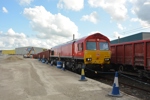Network Rail’s work to upgrade the Great Western route around Bath was completed at 1940 on August 31, ten hours ahead of schedule.
The work, which had started in July, is part of the scheme to electrify the Great Western Main Line, and involved lowering track and replacing infrastructure along 10 1/4 miles of track.
This was the largest possession for track renewals in Britain’s railway history, and cost £50 million. According to Network Rail, there were no reportable injuries during the work, and just 26 calls were made to its helpline.
Brunel’s Box Tunnel, one of the most famous features of the line, was shut for the entire six-week period of works, to allow the track to be relaid. The intense work involved 133 engineering trains and 9,000 yards of new track, and was unable to continue at night because the listed tunnel contains protected species of bats.
High output ballast trains were used in many parts of the renewals project, and tamping was carried out using eight tampers on 46 shifts, with three more in reserve.
Box Tunnel and the Bathampton Junction to Thingley Junction section were closed for the duration of the work. All lines east of Bath were closed from August 1.
















Login to comment
Comments
No comments have been made yet.